
Stop overpaying - start transferring money with Ogvio. Sign up, invite friends & grab Rewards now! 🎁
Imagine a questing platform that not only rewards your quest-solving skills but also elevates the experience with cutting-edge features, such as a groundbreaking digital ID tailored for the Web3 world. That's precisely what we'll be looking into in this Galxe review.
I've dropped a hint about what is Galxe (previously Project Galaxy), so I won't go into specifics just yet. Just know that it transcends the typical questing platform. Much like BitDegree serves as a comprehensive learning hub with questing features, Galxe emerges as a sophisticated credential network that extends far beyond the realm of quests.
However, BitDegree's Web3 Exam and Missions provide a gamified and incentivized learning experience for those who want to learn about all the intricacies of Web3. Galxe, on the other hand, is more for those who want to familiarize themselves with new or already established Web3 projects.
Is Galxe legit, though? What is the actual purpose of Galxe? Let’s answer these and many other questions.
Verdict at a glance: Galxe is a questing platform that goes beyond the ordinary, also offering other features like credentials, Galxe ID, and even developer-friendly Oracle application modules. However, the heart of Galxe still lies in its incentivized quests, providing a diverse array crafted by various Web3 projects. It even has some educational quests for newcomers. Though, several Galxe reviews claim that the platform might be a tad confusing.
Pros
- Community-oriented
- Galxe ID
- A separate, dedicated protocol
- Educational quests available
Cons
- Might be a bit tricky to navigate for beginners
Table of Contents
- 1. What is Galxe?
- 2. Galxe Review: PROS
- 2.1. Popular and Upcoming Communities
- 2.2. From Community Engagement to Education
- 2.3. Tokens, NFTs, OATs, Discord Roles, and More
- 2.4. More Than Just A Questing Platform
- 3. Galxe Review: CONS
- 3.1. More Features, More Confusion
- 4. Galxe VS Alternatives
- 4.1. Galxe VS BitDegree
- 4.2. Galxe VS Zealy
- 4.3. Galxe VS Layer3
- 5. Conclusions
What is Galxe?
If you’ve read other Galxe reviews, you might have noticed it being described in several ways - a crypto project focused on building communities, a blockchain protocol, a Web3 platform that creates an open credential data network, or the everything app for the Web3 space.
So, what is Galxe, exactly? Well, apart from the “everything app”, I’d say it’s all of the above. Though, this answer doesn’t make it less confusing, right? Let’s simplify things:
- Quest Platform. For one, Galxe is a questing platform where various Web3 projects can create communities and incentivized quests or the so-called “campaigns”. The campaigns attract new members to their communities, while the members can earn some lucrative rewards for simply completing tasks.
- Credential Data Network. Secondly, Galxe creates a collaborative credential data network that allows users to own, manage, and share verifiable credentials.
- Protocol. Lastly, Galxe is a zero-knowledge-proof-powered protocol that acts as a permissionless self-sovereign identity infrastructure. It provides developers with Oracle application modules and APIs for integrating credentials into their products.
Now, note that I will mostly focus on Galxe as a questing platform. Though, I’ll also tell you a bit more about its other features later in this Galxe review, too. That said, let’s try to figure out what is the purpose of Galxe together.
Galxe Review: PROS
There are many ways one can analyze Galxe features. Yet, my approach typically involves reviewing platforms through their advantages and disadvantages. So, let’s do just that in this Galxe review, beginning on a positive note.
Popular and Upcoming Communities
I’d say that building Web3 communities is the primary purpose of Galxe. After all, once you go to its homepage, the first thing you’ll see is an encouragement for users to earn by contributing to said communities.
These communities are referred to as “Spaces,” and there already are over 3 thousand Spaces, including BitDegree, BNB Chain, Avax, and others.
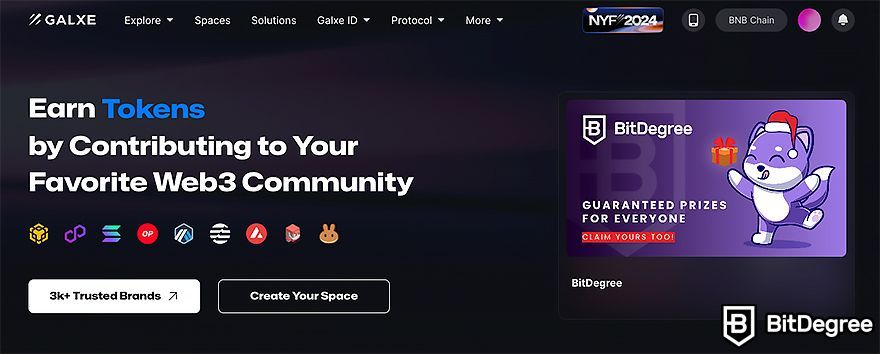
What is the exact purpose of Galxe in Space creation?
It simply acts as a mediator between Spaces and new users. Spaces are provided with a permissionless launchpad for creating campaigns, while users are provided with a place where they can find thousands of campaigns that offer various rewards.
To become a part of a Space, you just need to follow the one you want to join and participate in their campaigns. Each campaign might include different tasks and offer different rewards, but I’ll talk about them later in this Galxe review.
Now, suppose you’re wondering how to use Galxe to build your own Space. In that case, you first need to fill out an application, describing your project / community and providing your social media links. There are a few requirements set in place, though, which means that not everyone can create a Space on Galxe:
- Your X (formerly Twitter) account must have at least 200 followers;
- You must deposit 300 GAL or provide an Invite Code;
- You must add an email address to your Space and verify it.
Upon completing these steps, your account will undergo automatic approval. The requirement for projects to meet a specific threshold before creating a Space effectively addresses the question, “Is Galxe legit?” – it seems that it is.
While we’re on the topic of Spaces, do note that Galxe offers a tiered program for them. Advancing to higher tiers involves completing tasks such as gaining a specific number of followers or attracting participants to campaigns. However, the program operates in seasons, leading to potential changes in tasks and benefits.
Speaking of benefits, higher Space levels get more Gas Station credits, campaign boosts, and even primary access to beta features.

What on earth are Gas Station credits? No, they’re not credits that will cover your car fuel expenses. The Gas Station on Galxe is a pretty nifty feature that can help Spaces reach higher campaign completion rates.
You see, even though there are no Galxe fees when it comes to taking quests, users often encounter gas fees (also known as network fees) when claiming their well-earned NFTs or tokens. This is simply the case because all actions on the blockchain incur such fees.
With Gas Station credits, however, Spaces can cover the fees for their campaign participants, improving their experience and increasing participation.
That said, it’s worth noting that not all Spaces do that. For example, when it comes to the campaigns I personally participated in, I had to cover my own gas fees. Though, these fees usually cost just a couple of pennies.
Now, let's proceed with this Galxe review exploring the tasks offered in campaigns.
From Community Engagement to Education
I’d say that the majority of tasks that appear in Galxe campaigns are pretty much the standard for questing platforms.
The most popular tasks are those that include community engagement interactions, such as sharing something on social media, participating in virtual events, engaging in discussions, and so on. This type of tasks is the most important for the growth of communities, and it’s also the most effortless to complete for campaign participants.
Another type of tasks that is very common on Galxe is those that ask participants to complete specific actions on the platform in question. For example, if it’s an exchange, you might need to make some trades on it. If it’s an educational platform, you might need to check out its learning material. Basically, you can be asked to use a platform in any way, with the aim of getting familiar with it.

Then, there are also those tasks that might ask you to complete certain on-chain actions. This could include making transactions on a specific blockchain, swapping tokens, or acquiring NFTs. I think these are the most intimidating tasks for questers because they might involve spending actual money.
Lastly, there are tasks that can include educational material and quizzes. Though, this is the least common type on Galxe because communities are usually focused on introducing campaign participants to their products rather than teaching them something about the Web3 space as a whole. If you actually want to learn, you should check out BitDegree’s Web3 Exam and Missions.
However, Galxe itself encourages learning, which is why it released a campaign collection called “Mission Web3”. It is somewhat similar to what BitDegree offers in that its participants earn rewards by learning about Web3 and completing quizzes to test their knowledge.
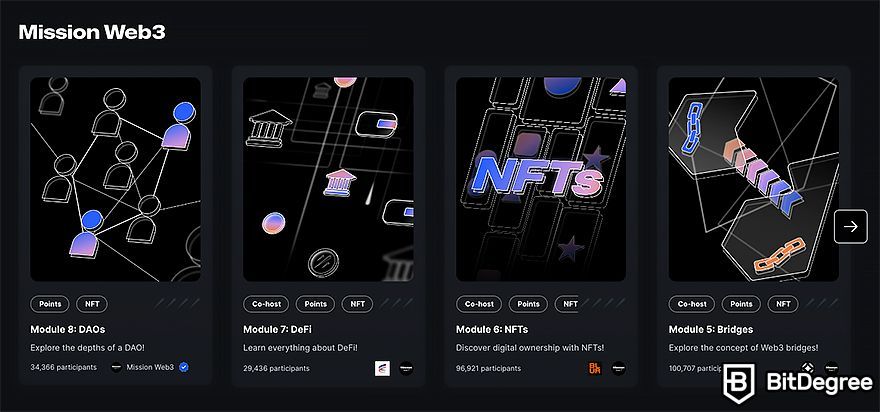
By the way, campaign collections are like events that are made up of several campaigns, providing participants with more tasks and, naturally, more rewards.
The last thing you need to know about campaigns is that some might have participation requirements. For example, you might need to be a new user to participate, or you might need to have already completed several campaigns made by the same Space.
Now that you know all about tasks, let’s get to the most exciting part of this Galxe review – rewards.
Tokens, NFTs, OATs, Discord Roles, and More
Let’s be frank, once you see that you can get valuable rewards for doing something, your interest rises exponentially (at least, I know that’s the case for me). So, if you’re after quests because you want to get some freebies, Galxe is a pretty good choice as it offers a variety of rewards:
- Loyalty Points. Untransferable points that increase your standing in a Space. By accumulating more points, you’ll raise your rank in the leaderboard and might even get some custom rewards.
- Tokens. Pretty self-explanatory – you can claim some tokens for completing tasks. Could be USDC, MATIC, GAL, or any other.
- OAT (On-chain Achievement Tokens). A digital badge standard that records on-chain life experiences. In other words, it’s a sort of an NFT badge or on-chain credential that proves you’ve completed certain actions. They might later be used as tickets, making you eligible for airdrops or other exclusive events.
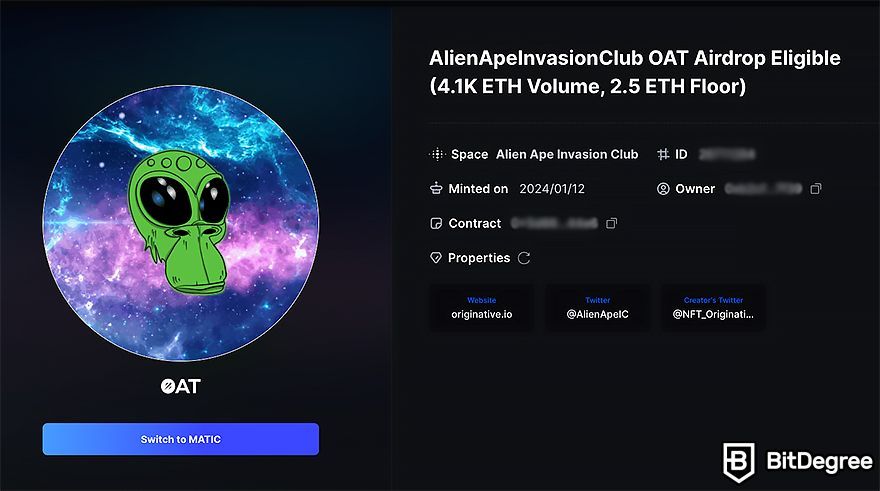
- Custom Rewards. Projects can also offer custom rewards, this way having the possibility to set more unique parameters and conditions. Custom rewards could include whitelist spots, soulbound tokens, XP points on some games, and whatnot.
- Discord Roles. You can get various roles on Discord – Novice, Captain, Officer, Major, you name it. There’s not much more to explain here.
- Mintlist. Also known as an NFT Allowlist. It’s like an invitation or a ticket to an exclusive NFT sale or auction.
- NFTs. You also have the opportunity to acquire unique NFTs that may not be accessible through any other means. These one-of-a-kind non-fungible tokens offer a distinctive and exclusive ownership experience, adding an extra layer of rarity and value to your collection.
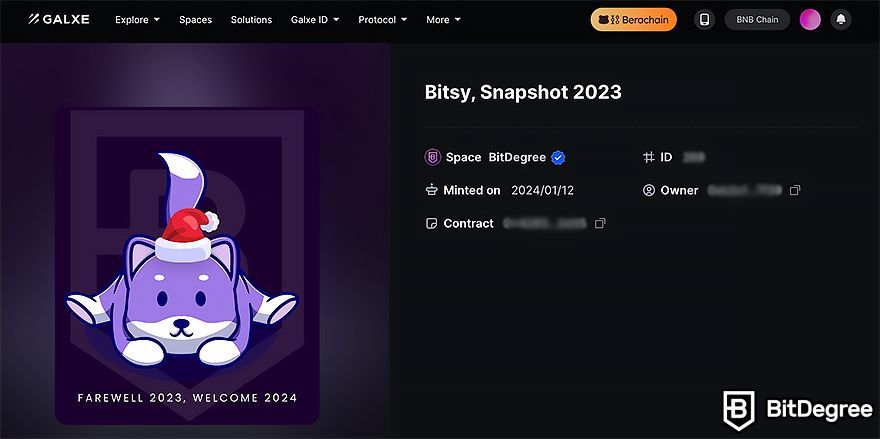
Of course, keep in mind that each campaign might offer different rewards; it all depends on the Space that created the quest. Besides, one campaign can have multiple rewards.
Now, there are two ways the rewards can be distributed: FCFS (First Come, First Served) or Raffle. FCFS means that, as long as there are available rewards, you’ll be able to claim them immediately after completing a campaign. Raffle, though, is just like a “lucky draw” where winners are selected at random.
The last thing you need to know about rewards is related to Galxe pricing. Or, to be more precise, the aforementioned gas fees. As you already know, to claim tokens or NFTs, you’ll need to pay gas fees. However, there is this feature called Smart Balance.
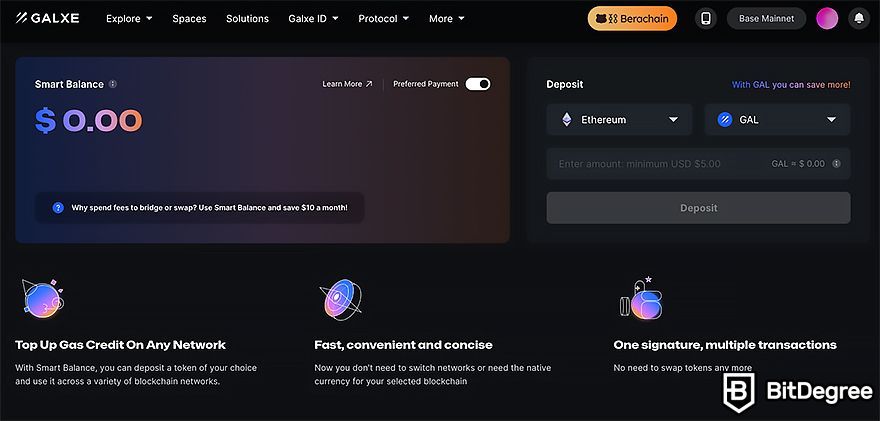
Smart Balance is sort of a smart wallet that simplifies your experience on Galxe and reduces gas fees. You just need to top it up with some crypto, like GAL, USDT, USDC, ETH, BNB, or MATIC, and then you can use it to cover any network fees on Galxe.
Just note that topping up Smart Balance incurs Galxe fees – 10% of the gas fee when making non-GAL deposits or 5% of the gas fee when making GAL deposits.
That’s pretty much all the basics you need to know about Galxe rewards. Now, let’s talk about other Galxe features.
More Than Just A Questing Platform
So far, in this Galxe review, I’ve covered Galxe as a quest platform. However, as you already know, it’s much more than that.
For instance, a pretty important Galxe feature is its credential network. Simply put, credentials are records of digital activities. There can be various types of off-chain and on-chain credentials, including Discord credentials, X credentials, Telegram credentials, and so on.
What are these credentials used for? Well, for instance, they are used when making campaigns on Galxe. Let’s say you ask a participant to like a post on X. So, you add an X Like credential, which will track the user’s actions and prove whether they liked the post or not.
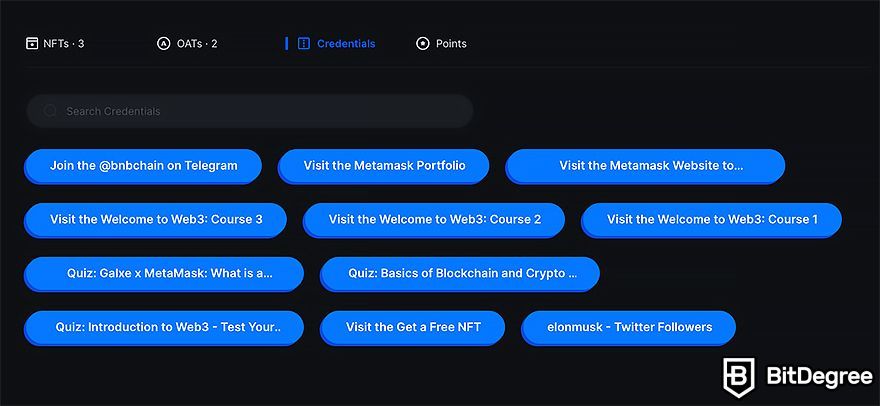
Of course, credentials can also be used outside Galxe campaigns. Maybe you need to check when (and if) a user joined your Discord channel – Galaxy credentials can be used to do that. Basically, credentials are like a filtering system that aids projects when they want to reward their communities, calculate credit scores, build voting systems, and so on.
Though, there are even more possible use cases for them in the future. For example, some argue that blockchain-backed educational credentials have the potential to directly impact an individual's employability[1]. How? Well, the broader range of experiences collected from various sources during a student's journey could be proven using credentials.
However, enough about credentials. If you’ve read other Galxe reviews, you’ve probably noticed the term “Galxe ID” mentioned once or twice. How does Galxe ID work and what is it, in the first place?
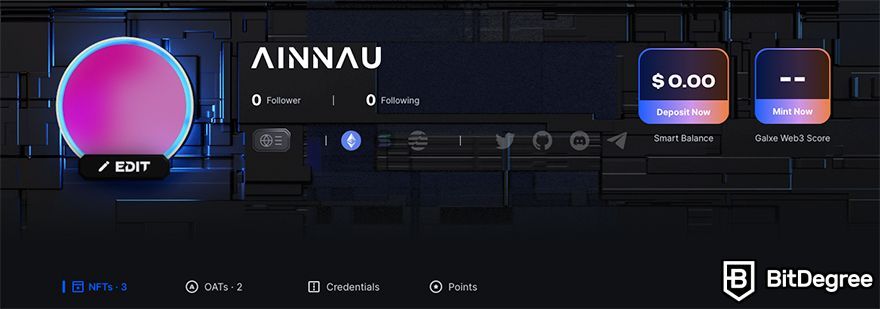
Put briefly, Galxe ID is a universal identifier that is tied to your wallet address. It allows you to showcase your accomplishments and qualifications, including your credentials and NFTs, points or OATs claimed during Galxe campaigns.
So, in a way, it works like your national identification number, which can be used to access various types of information about you, just on the blockchain.
Then, there’s also the Galxe Web3 Score, which is a numerical representation of your activity and reputation within the Web3 ecosystem. It's calculated based on various factors such as transaction history, engagement in dApps, and participation in the broader blockchain community.
It has 5 sub-scores, including experience, fame, assets, expertise, and humanity. Besides, the Web3 Score is dynamic, changing based on your ongoing activities and contributions to the ecosystem. So, basically, it’s somewhat like a credit score.
Just note that while there's no Web3 Score minting fee, you will have to pay a subscription fee (5 USDT).
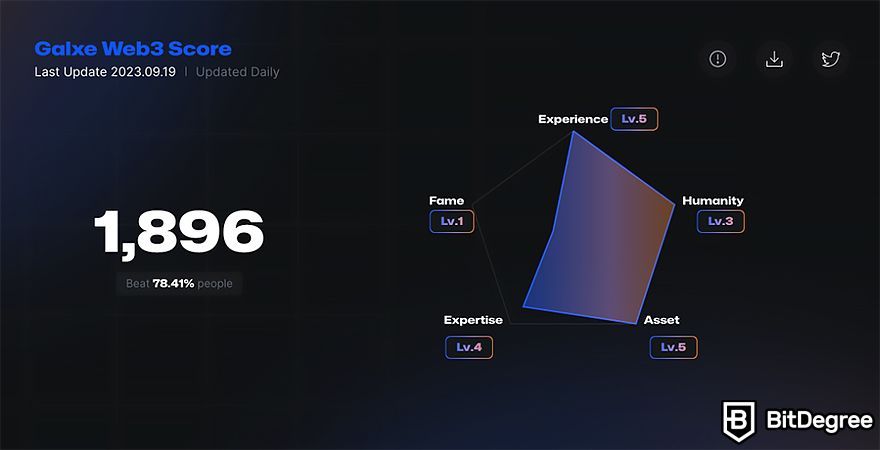
Furthermore, there is the Galxe Passport, which is not the same as the Galxe ID. Instead of showcasing your achievements, it stores your identity information. Thus, the main use case of the Galxe Passport is the hassle-free verification of your identity across various Web3 applications.
How to use Galxe to get it? You simply need to mint it. However, you’ll need to verify your identity using your driver’s license, state identification, or international passport. Once you do that, you’ll receive the Galxe Passport Soulbound Token in your wallet. Since the token is untransferable, it provides you with extra security from Sybil attacks.
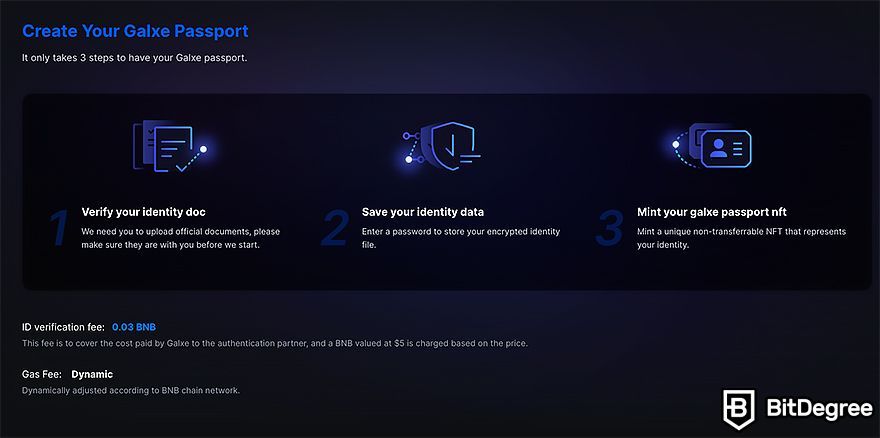
How is user data stored in Galxe Passport, and is Galxe safe, in the first place?
It seems that Galxe is quite safe. The data on the Galxe Passport is encrypted with a password and stored in an off-chain vault, so no one can access it without your permission. This also means that the data belongs only to you – neither Galxe nor any other platform can access it without your permission.
Now, the last big part of the ecosystem that’s highly discussed in many Galxe reviews is the GAL token. While not delving into exhaustive details, it's worth noting that GAL mostly serves two purposes: it acts as a governance token and a payment method.
When it comes to governance, GAL provides holders with voting rights in the Galxe DAO. As for being a payment method, you already know that it can be used to top up your Smart Balance. In addition to that, though, GAL is used to cover Galxe pricing for using the credential network, Oracle application models, and APIs.
You can check the current Galxe price on BitDegree’s crypto tracker.
That said, let’s proceed to the less cheerful part of this Galxe review.

Did you know?
All Crypto Exchanges may look similar to you but they're NOT all the same!
Galxe Review: CONS
We’ve covered all the pros related to Galxe features. Now, let’s look into the cons. Even though I didn’t see many cons mentioned in other Galxe reviews, I did notice one myself – Galxe has a pretty steep learning curve.
More Features, More Confusion
Galxe definitely is confusing, which can be a significant obstacle for both newcomers and experienced users. Until you’ve fully figured the platform out, it’s even hard to answer what is Galxe.
After all, it offers a variety of advanced functions like credentials, the Galxe ID, the Galxe Web3 Score, and the Galxe Passport. These features, while powerful and great, contribute to a complex and somewhat opaque system at times that challenges users in terms of accessibility and ease of use.

Besides, this complexity is not limited to the advanced features alone. Even the questing aspect of Galxe, which ideally should be straightforward, ends up being a little bit confusing.
For example, even though the platform employs mechanisms similar to other questing platforms in the Web3 space, it introduces its own terminology and structure, complicating the user experience for some.
Galxe VS Alternatives
Now, after reading this Galxe review, you probably have a pretty good understanding of what is Galxe and what its purpose is. So, the last thing I want to do is compare it to other similar platforms.
Galxe VS BitDegree
At first glance, it might not seem that Galxe and BitDegree are similar. While Galxe is a community building platform, a credential network, and a zero-knowledge-proof-powered protocol, BitDegree is an all-in-one learning platform focused on providing users with all the tools they might need to become Web3-savvy.
However, BitDegree’s Web3 Exam and Missions provide users with incentivized quests, too, just like Galxe does. Okay, maybe not exactly like Galxe, but there are some similarities.
BitDegree’s Web3 Exam and Missions are actually a bit similar to Galxe’s Mission Web3 campaign collection in that they provide users with educational quests where they have to learn, solve quizzes and then claim rewards.
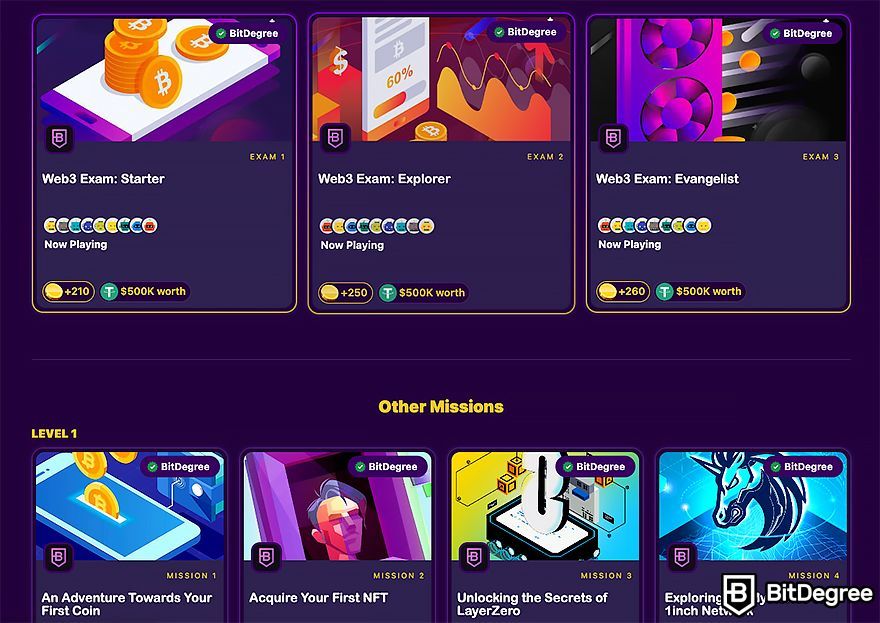
Though, for some, BitDegree’s products might seem a bit more thought-through and fun. They employ gamification elements and cater to various levels of expertise, from newbies to experts. Also, most of the action happens inside BitDegree’s interface with built-in learning materials and exciting quizzes, so you’ll rarely have to jump between different pages, as you do with Galxe.
Reward-wise, BitDegree also gives participants a chance to win lucrative prizes like tokens, NFTs, various subscription plans on established Web3 platforms, and even some physical rewards, like hardware wallets.
Additionally, all successful Web3 Exam participants are able to mint their NFT Certificates of Completion featuring their knowledge level and Exam score (without paying any gas fees). I’d say this NFT certificate is somewhat like a mix of Galxe ID and Web3 Score.

Of course, some tasks on BitDegree might take a bit longer than simply following a few social media channels of some Web3 project, but they are a lot more rewarding, both intrinsically and extrinsically. BitDegree understands that achievement-based motivation is as important as reward-based motivation[2].
All in all, I think both platforms are great, but they cater to slightly different audiences. Galxe is for those who seek fast quests, usually involving community engagement tasks, while BitDegree is for those who want to learn something useful about Web3 as a whole and earn lucrative rewards while they are at it.
Galxe VS Zealy
Both Galxe and Zealy function as quest launchpads, allowing various Web3 projects the creation of communities and incentivized quests.
When it comes to that, Galxe and Zealy don’t differ that much. On both platforms, you can find a huge variety of popular and newcomer communities offering a variety of quests. Of course, quite often, these quests involve community engagement actions, like doing something on social media channels or trying out the platform in question.
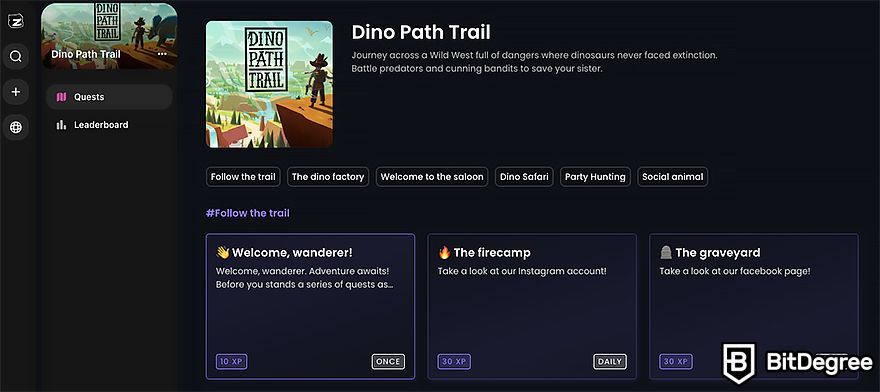
However, I’d say that Zealy is a little bit more user-friendly; its page navigation is pretty straightforward, and there are no additional features. On the other hand, though, I’ve noticed that Galxe campaigns usually offer more exciting rewards.
That said, if you’re interested in some advanced features beyond quests, Galxe might be a more suitable option, but if you’re after ease of use, you might want to go with Zealy (or, you can always give it a try to both).
Galxe VS Layer3
Now, Layer3 is more like BitDegree than Galxe because it puts more emphasis on the education-based approach. Besides, it seeks to make it fun with various gamification elements.
The overall appearance of the Layer3 website resembles retro games. Additionally, it has a very user-friendly interface, making it easy to navigate and understand the platform. That’s something Galxe lacks.

Though, what Layer3 lacks is a bit more clarity when it comes to rewards – you can’t just set a filter and see which quests offer tokens, for example. Also, XP points and Mystery Chests are some of the more common rewards on Layer3, which means you won’t be fully sure what you’ll get until you finish the quest in question.
To sum up, Layer3 is a great fit for those searching for a gamified and hassle-free questing experience, while Galxe offers a more advanced ecosystem and more exciting rewards.
Conclusions
Now that the cards are on the table, what do you think is the purpose of Galxe? Even though there’s a lot of buzz about its native token and credential data network in other Galxe reviews, I’d say that one of the primary Galxe’s purposes is growing Web3 communities.
After all, it acts as a launchpad where these communities can create their Spaces and roll out enticing campaigns. The participants of these campaigns dive into simple tasks, unlocking a treasure trove of rewards – tokens, NFTs, and more. However, some Galxe reviews claim that amidst a myriad of other Galxe features, the platform might seem like a labyrinth at first.
If user-friendliness is your vibe, you should check out BitDegree's Web3 Exam and Missions. Here, quests and amazing rewards blend seamlessly into a gamified questing experience. Plus, you’ll enroll yourself in an educational odyssey, because BitDegree's main purpose is teaching the masses about the wonders of Web3.
That said, don't waste any time and enroll now. You might get a chance to win some exclusive rewards that you won't be able to get later!
The content published on this website is not aimed to give any kind of financial, investment, trading, or any other form of advice. BitDegree.org does not endorse or suggest you to buy, sell or hold any kind of cryptocurrency. Before making financial investment decisions, do consult your financial advisor.
Scientific References
1. A. Grech, I. Sood, L. Ariño: 'Blockchain, Self-Sovereign Identity and Digital Credentials: Promise Versus Praxis in Education';
2. J. Cameron, W. D. Pierce, K. Banko, et al: 'Achievement-Based Rewards and Intrinsic Motivation: A Test of Cognitive Mediators'.


